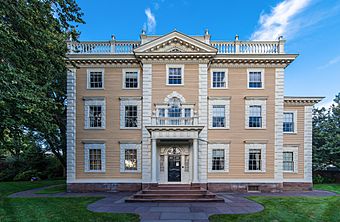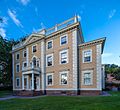Nightingale–Brown House facts for kids
|
Nightingale-Brown House
|
|
|
U.S. National Historic Landmark District
Contributing Property |
|

Front elevation, 2008
|
|
| Location | 357 Benefit St., Providence, Rhode Island |
|---|---|
| Area | 1 acre (0.40 ha) |
| Built | 1792 |
| Architect | Caleb Ormsbee |
| Architectural style | American Colonial, Georgian, Italianate |
| Part of | College Hill Historic District (ID70000019) |
| NRHP reference No. | 89001242 |
Quick facts for kids Significant dates |
|
| Added to NRHP | June 29, 1989 |
| Designated NHL | June 29, 1989 |
| Designated NHLDCP | November 10, 1970 |
The Nightingale–Brown House is a very old and important house located at 357 Benefit Street in Providence, Rhode Island. It sits on College Hill. Today, it is home to the John Nicholas Brown Center for Public Humanities and Cultural Heritage at Brown University.
This house is special because it is one of the largest wooden houses from the 1700s that is still standing. It is also important because it was the home of the famous Brown family for many years, from 1814 to 1985. The Brown family members were important leaders in Providence's community, business, and social life. Some even played a big part in America's industrial growth in the 1800s. In 1989, the house was added to the National Register of Historic Places and named a National Historic Landmark.
Contents
What the House Looks Like
The Nightingale–Brown House is a large, three-story building made of wood. It sits on a property about 1 acre (0.40 ha) in size. Colonel Joseph Nightingale had it built in 1791.
The front of the house has five sections, with a part that sticks out in the middle. The main door has windows on its sides and a special fan-shaped window above it. This fanlight window is one of the first of its kind used in the United States. A square porch with columns covers the entrance.
Above the doorway is a large, fancy window called a Palladian window. The corners of the house and its sections have decorative stone-like blocks called quoins. The windows on the first two floors also have special frames. The main part of the house has a hip roof with a low railing around it. This look is very similar to how the house appeared in a drawing made in 1802.
Changes Over Time
In 1814, Nicholas Brown, Jr. bought the house. His family owned it until 1985, when Anne S.K. Brown passed away and gave it to Brown University.
Over the years, some parts were added to the house.
- In 1853, John Carter Brown hired an architect named Thomas Tefft to design a building for carriages.
- In 1858, a two-story section was added to the south side of the house. It's not known if Tefft designed this part, but it looks similar to the carriage house.
- In 1862, Brown hired another architect, Richard Upjohn, to design a library wing. This was built between 1862 and 1864. It is northeast of the main house and creates a courtyard with the carriage house. Like the earlier addition, this new part also matches the style of the original 1791 house.
- In 1890, Frederick Law Olmsted, a famous landscape designer, planned the gardens and outdoor areas. His work can still be seen today, even with some small changes.
Important People Who Lived Here
The Nightingale–Brown House was home to many important members of the Brown family.
- Nicholas Brown, Jr. was the son of Nicholas Brown, Sr., a leading merchant in Providence. Nicholas Brown, Jr. was a key figure in developing industries in the early 1800s. He gave so much money to the local college that it was renamed Brown University in his honor. He also served in the state government and helped start the Providence Athenaeum, a library and cultural center.
- John Carter Brown is best known for collecting a very large library of books. This collection is now owned by Brown University and is called the John Carter Brown Library.
- Anne S. K. Brown was the last Brown family member to live in the house. She collected a huge number of military documents and items. These are also now part of the university's collections.
- J. Carter Brown, Anne S. K. Brown's son, grew up in this house. He later became the director of the National Gallery of Art, a very famous art museum.
John Nicholas Brown Center for Public Humanities
The John Nicholas Brown Center for Public Humanities and Cultural Heritage is currently located in the Nightingale–Brown House. The Center started in 1979 as the John Nicholas Brown Center for the Study of American Civilization. It became part of Brown University in 1995.
The Center works with local, national, and international groups on projects related to the humanities. This includes art, history, education, and community involvement. The Center also offers a master's degree program in Public Humanities through Brown University.
Gallery





